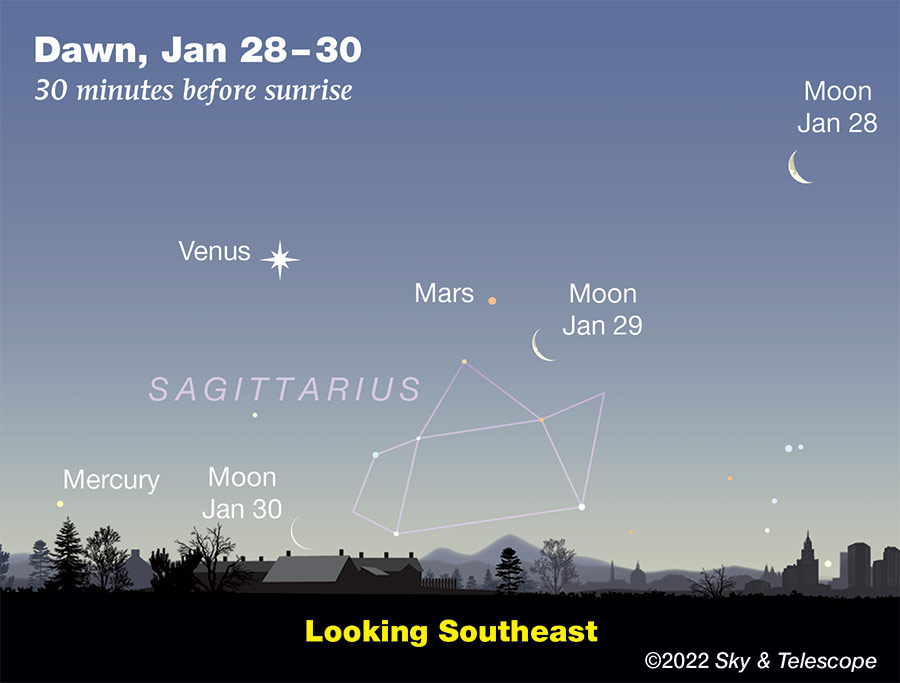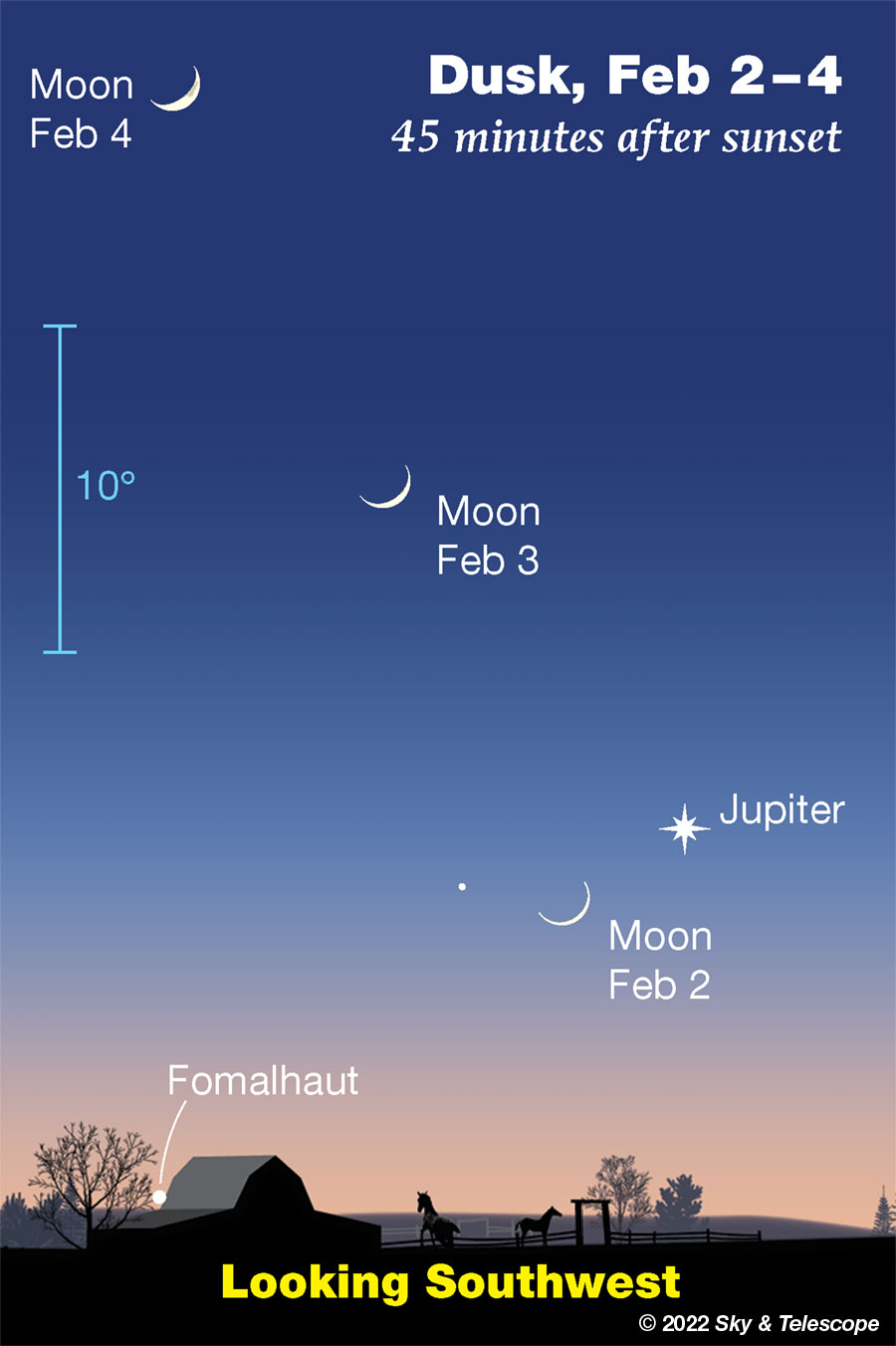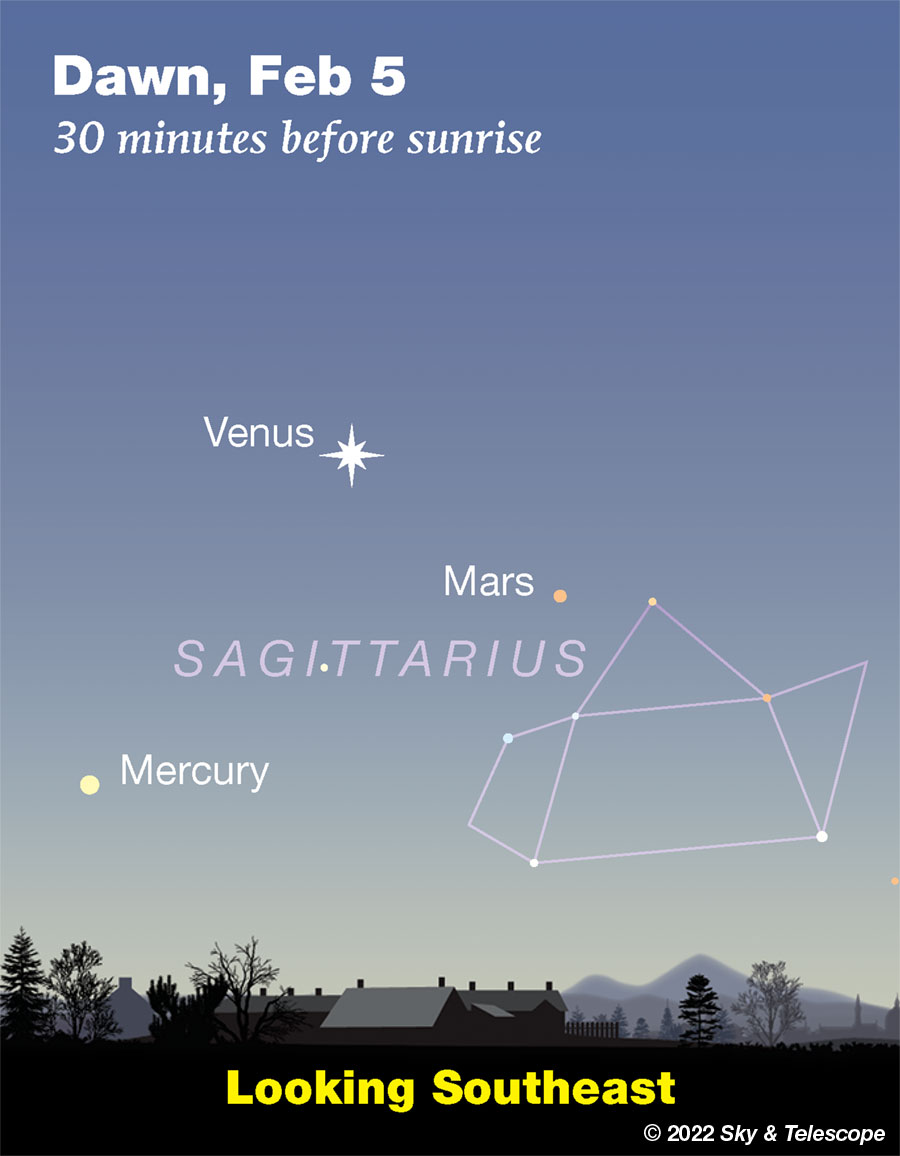FRIDAY, JANUARY 28
■ Right after dark, face east and look very high, almost straight up. The bright star there is Capella, the Goat Star. To the right of it, by a couple of finger-widths at arm's length, is a small, narrow triangle of 3rd- and 4th-magnitude stars known as "The Kids." Though they're not exactly eye-grabbing, they form a never-forgotten asterism with Capella.
■ Capella is the leading light of Auriga the Charioteer, riding high on the winter Milky Way these moonless nights. Telescopic targets in central Auriga, working out from the Leaping Minnow and False Minnow asterisms, are charted in Ken Hewitt-White's "Suburban Stargazer" column in the January Sky & Telescope, page 54.

SATURDAY, JANUARY 29
■ Spot the equilateral Winter Triangle in the southeast after dinnertime. Sirius is its brightest and lowest star. Betelgeuse stands above Sirius by about two fists at arm's length. To the left of their midpoint is Procyon.
Can you discern their colors? Sirius (spectral type A0) is cold white, Betelgeuse (M2) is pale orange, and Procyon (F5) is much paler yellowish white.
And standing 4° above Procyon is 3rd-magnitude Gomeisa, Beta Canis Minoris, the only other easy naked-eye star of Canis Minor.
■ Meanwhile the Great Square of Pegasus is sinking in the west, tipped onto one corner. And the Big Dipper is creeping up in the north-northeast, tipped up on its handle.
SUNDAY, JANUARY 30
■ Orion is now high in the southeast right after dark, and he stands his highest due south by 8 or 9 p.m. Orion is the brightest and showiest of the 88 constellations — and that often distracts from the fact that his main pattern is surprisingly small compared to some of his dimmer neighbors. The biggest of these is Eridanus the River to his west, enormous but hard to trace. Dimmer Fornax the Furnace, to Eridanus's lower right, is almost as big as Orion! Even the main pattern of Lepus, the Hare cowering under the Hunter's feet, isn't much smaller than he is. Bunny as megafauna.
■ Do you know the constellation below Lepus? It's a tough one: Columba the Dove, faint, sprawly, and to my eye not a bit dove-like. See the constellation chart in the center of the February Sky & Telescope. Its brightest star, Alpha Columbae or Phact, is magnitude 2.6. To find it, draw a line from Rigel through Beta Leporis (the front of the bunny's neck) and extend it an equal distance straight on.
MONDAY, JANUARY 31
■ Sirius the Dog Star blazes in the southeast after dinnertime, the brightest star of Canis Major. In a dark sky with lots of stars visible, the constellation's points can be connected to form a convincing dog profile. He's currently standing on his hind legs. Sirius is on his chest, to the right or lower right of his faint, triangular head.
But through the light pollution where most of us live, only his five brightest stars are easily visible. These form the short-handled Meat Cleaver. Sirius is the cleaver's top back corner, its blade faces right, and its handle is down below pointing lower left. It's Canis Major's tail.
TUESDAY, FEBRUARY 1
■ The sky's biggest asterism (informal star pattern) — at least the biggest one that's widely recognized — is the Winter Hexagon. It fills the sky toward the east and south these evenings. Start with brilliant Sirius at its bottom. Going clockwise from there, march up through Procyon, Pollux and Castor, Menkalinan and Capella on high, down to Aldebaran, then to Rigel in Orion's foot, and back to Sirius. Betelgeuse shines inside the Hexagon, off center.
The Hexagon is somewhat distended. But if you draw a line through its middle from Capella down to Sirius, the "Hexagon" is fairly symmetric around that long axis.
■ Take hold of the line from Aldebaran to Capella, twist it to go from Aldebaran to Betelgeuse instead, and the Winter Hexagon becomes the Heavenly G.
■ Today is Imbolc or Saint Brigid's Day, one of the four traditional "cross-quarter" days midway between the solstices and the equinoxes. More or less. In the many centuries after this tradition took hold in the British Isles, the calendar drifted with respect to Earth's position in its orbit, until our current Gregorian calendar system was instituted a few centuries ago to put an end to such problems. So this winter, the midpoint between the December solstice and the March equinox actually falls on February 3rd: at 10:42 p.m. Eastern Standard Time (3:42 February 4th UT.)
That minute is the exact center-balance of astronomical winter: the very bottom of the circle of the year as defined by the astronomical seasons.
Groundhog Day (or its German weather-predicting predecessor, Badger Day) was originally the winter cross-quarter day — but it came a bit unmoored and is now considered to be February 2nd.
■ New Moon (exact at 12:46 a.m. on this date EST).
WEDNESDAY, FEBRUARY 2
■ Look low in the southwest for the Moon pairing up with Jupiter, the "false Evening Star" (it tries to match Venus when it's in this part of the sky, but it always falls short). At dusk in the North American time zones, the Moon and Jupiter are 4° or 5° apart. That's about the width of two or three fingers at arm's length. How early after sunset can you begin to see them?

THURSDAY, FEBRUARY 3
■ This evening and tomorrow evening in twilight, the curved outer edge of the crescent Moon aims nearly at Jupiter like a bow shooting an arrow at it; see above. Why does the crescent Moon do this so often to planets— but not always? Answer at the bottom of the page.
FRIDAY, FEBRUARY 4
■ Have you ever closely compared the colors of Betelgeuse and Aldebaran? Can you detect any difference in their colors at all? I can't, not really. Yet Aldebaran, spectral type K5 III, is often called an "orange" giant, while Betelgeuse, spectral type M1-M2 Ia, is usually called a "red" supergiant. Their temperatures are indeed slightly different: 3,900 Kelvin and 3,600 Kelvin, respectively, a difference of 8%.
A complication! Betelgeuse is brighter, and to the human eye, the colors of bright objects appear, falsely, to be desaturated: paler (whiter) than they really are. You can get a slightly better read on the colors of bright stars by defocusing them a bit, to spread their light over a larger area of your retina.
■ The solar system has four terrestrial (rocky) planets: Mercury, Venus, Earth, and Mars. All four are currently visible at dawn, as shown below.

SATURDAY, FEBRUARY 5
■ After it’s good and dark, look due east, not very high, for twinkly Regulus. Extending upper left from it is the Sickle of Leo, a backward question mark. "Leo announces spring," goes an old saying. Actually, Leo starting to show up in the evening announces the cold, messy back half of winter. Come spring Leo will already be high.
This Week's Planet Roundup
Mercury begins to emerge from solar conjunction very low in the dawn late this week. But it's relatively faint; even by February 4th it's still only magnitude +0.6. Search for it with binoculars about 15° lower left of Venus about 50 or 40 minutes before sunrise.
Venus, brilliant at magnitude –4.8, is a bit higher in early dawn each week. You can't miss it shining moderately low in the southeast. In a small telescope it's a dazzling thin crescent, getting just a little thicker and smaller each day.
Mars, vastly fainter at magnitude +1.4, glimmers to the right or lower right of Venus in early dawn. They're about 10° apart on the morning of January 29th, closing a little to 8° by a week later. Mars, Venus, and Mercury are all in Sagittarius.
Brighter Antares in Scorpius shines some 25° upper right of Mars. Below Mars are fainter stars of the Sagittarius Teapot.
Mars is on the far side of its orbit from us, so in a telescope it's just a tiny blob 4.3 arcseconds wide. Be patient; Mars is on its long, slow way to opposition next December, when it will reach an apparent diameter of 17 arcseconds.
Jupiter (magnitude –2.0, in Aquarius) still shines brightly in the southwest at dusk, a little lower every day.
Saturn is out of sight in conjunction with the Sun.
Uranus (magnitude 5.7, in Aries) is very high in the south-southwest after dark. Finder chart.
Neptune (magnitude 7.9, in Aquarius) is getting low in the west-southwest after dark, invisible to the unaided eye some 15° upper left of Jupiter.
All descriptions that relate to your horizon — including the words up, down, right, and left — are written for the world's mid-northern latitudes. Descriptions and graphics that also depend on longitude (mainly Moon positions) are for North America.
Eastern Standard Time, EST, is Universal Time (also called UT, UTC, GMT, or Z time) minus 5 hours.
Want to become a better astronomer? Learn your way around the constellations. They're the key to locating everything fainter and deeper to hunt with binoculars or a telescope.
This is an outdoor nature hobby. For an easy-to-use constellation guide covering the whole evening sky, use the big monthly map in the center of each issue of Sky & Telescope, the essential magazine of astronomy.
Once you get a telescope, to put it to good use you'll need a detailed, large-scale sky atlas (set of charts). The basic standard is the Pocket Sky Atlas (in either the original or Jumbo Edition), which shows stars to magnitude 7.6.

Next up is the larger and deeper Sky Atlas 2000.0, plotting stars to magnitude 8.5; nearly three times as many. The next up, once you know your way around, are the even larger Interstellarum atlas (stars to magnitude 9.5) or Uranometria 2000.0 (stars to magnitude 9.75). And be sure to read How to Use a Star Chart with a Telescope. It applies just as much to charts onscreen as to charts on paper.
You'll also want a good deep-sky guidebook. A beloved old classic is the three-volume Burnham's Celestial Handbook. An impressive more modern one is the big Night Sky Observer's Guide set (2+ volumes) by Kepple and Sanner.
Can a computerized telescope replace charts? Not for beginners, I don't think, and not on mounts and tripods that are less than top-quality mechanically, meaning heavy and expensive. And as Terence Dickinson and Alan Dyer say in their Backyard Astronomer's Guide, "A full appreciation of the universe cannot come without developing the skills to find things in the sky and understanding how the sky works. This knowledge comes only by spending time under the stars with star maps in hand."
![]() Audio sky tour. Out under the evening sky with your
Audio sky tour. Out under the evening sky with your
earbuds in place, listen to Kelly Beatty's monthly
podcast tour of the heavens above. It's free.
"The dangers of not thinking clearly are much greater now than ever before. It's not that there's something new in our way of thinking, it's that credulous and confused thinking can be much more lethal in ways it was never before."
— Carl Sagan, 1996
"Facts are stubborn things."
— John Adams, 1770
*Answer to why the crescent Moon aims like a bow at planets. It's because the Earth, Moon, and planets all orbit in nearly the same plane: the plane of the ecliptic, with the Sun at the center. Because we live on a planet, we live in the plane of the ecliptic. So the plane appears to us as a line projected onto the sky, circling us all around. The Sun, Moon and planets always appear on or close to that line.
The Moon is a ball in space lit by the Sun. So its sunlit side always points at the Sun. Because any planet will be close to the ecliptic, it will also be close to the Moon-Sun line on the sky. So the sunlit edge of the Moon, as we see it, will point toward a planet or away from it.
Usually. Nothing in the universe is perfect; all nature is naturally messy. The Moon can appear as much as 5° off the ecliptic, and the planets can also depart several degrees from it. So the bow of the crescent Moon never aims its arrow quite perfectly at a planet (for more than an infinitesimal moment), and sometimes the aim is just totally wild of the mark. That can happen when the Moon appears close to a planet — like with Jupiter on February 2nd, as shown in the illustration for that date above.
 4
4








Comments
Rod
January 28, 2022 at 10:39 am
I was able to enjoy some stargazing on 26-Jan, including seeing the *the Kids* near Capella 🙂 Perhaps some more on Saturday evening, here is my log from Wednesday night. Seeing Jupiter with 4 Galilean moons and Castor as a double star was a delight. [Observed 1800-1930 EST/2300-0030 UT. Sunset 1721 EST. Last Quarter Moon 25-Jan-2022 1341 UT. Moonrise tonight 0742 UT/0242 EST. I used 10x50 binoculars and 90-mm refractor telescope with 14-mm for 71x views. True FOV a bit larger than 1-degree or 60 arcminutes. Two satellites passed by early near 1810 EST and 1846 EST. The first satellite passed Taurus heading south about as bright as Aldebaran, mv + 0.84. The second satellite passed moving ENE through Auriga and perhaps mv + 4.0 (Starlink). I could see Jupiter tonight before it set near 1944 EST. Cloud bands visible and the 4
Galilean moons. Castor was a lovely double star at 71x. Reports indicate the angular separation increased and about 5 arcseconds in 2021, ref - https://astronomy.com/magazine/news/2021/12/discoverthe-
skys-best-double-stars, so an easy split at 71x. At 15.9 pc, the double ~ 79.5 AU apart. M35 and NGC 2158 (open star clusters) visible in the view at 71x. I enjoyed views of M37, M36, and M38 (open star clusters) in Auriga at 71x and 10x50 binocular views. M45 (open star cluster) in Taurus lovely using 10x50 binoculars. M42 (nebula) in Orion using 10x50 binoculars, much nebulosity apparent and Orion's sword a great view. Using 10x50 binoculars I viewed M41 (open star cluster) in Canis Major. Clear skies, temperature -4C and getting colder tonight, -10C or colder. Coming back inside the wood burning stove very comfortable.]
You must be logged in to post a comment.
Rod
January 29, 2022 at 1:46 pm
I did some solar observing today after the Nor'easter moved by. Observed 1145-1230 EST/1645-1730 UT. "Sunspot AR2936 has rapidly grown into one of the largest sunspots of young Solar Cycle 25. It is now crackling with C-class solar flares and could soon pose a threat for stronger explosions. Credit: SDO/HMI" "BIG SUNSPOT ALERT: New sunspot AR2936 has rapidly grown into one of the largest active regions of young Solar Cycle 25, quadrupling in size in only 48 hours...The scale of this sunspot makes it an easy target for backyard solar telescopes. AR2936 has multiple dark cores larger than Earth, and the entire group stretches more than 100,000 km across the surface of the sun. This is an ideal sunspot for projection techniques." - ref spaceweather.com. I observed this morning using 90-mm refractor, 25-mm plossl, and glass white solar filter with #12 yellow filter, views 40x. Sunspot AR2936 was the feature region to enjoy. Earth size about 18 arcsecond angular size on the Sun. AR2936 size, some 2.5 arcminutes angular size. At 40x, the telescope resolved to 7.5 arcsecond. The Sun at 0.985 au distance, about 32.47 arcminute size. Telescope true FOV about 75 arcminutes. Blowing snow all around, pastures and fields covered with snow and brilliant Sun glare all around off the snow with blue sky and some cirrus. Temp -4C winds NW at 18 knots and gusting 26 knots. The telescope vibrated and bounced the image while I viewed more than a few times. I was able to see AR2935 region and others too with plage. This was an experience, solar observing after a Nor’easter moved by and near 5 inches of fresh snow with snow blowing around. This is different than a planetarium show 🙂 Wood burning stove cranked up too 🙂
You must be logged in to post a comment.
Rod
January 30, 2022 at 11:49 am
This morning near 0600 EST I was able to view Venus with unaided eyes. I must plan some early morning telescope times for Venus and Mars in Sagittarius. Given Mars small 4.3 arcsecond size or so, I will need to view at 130-200x. This morning, snow all around in the woods, fields, and pastures, clear skies and temperature -12C/10F.
You must be logged in to post a comment.
mary beth
January 31, 2022 at 1:41 pm
Good reports Rod! You are pretty hardy to get out there in extreme weather! I’m glad you survived the nor’easter! I think the “real thing” is better than the planetarium. You are enjoying (even savoring) all that nature offers, a rare event these days as most people are inside on the computer. We’ve had clear skies on and off and I have definitely enjoyed Orion and Jupiter and all the stars in the east in the evening. Been seeing Canopus on and off depending on the weather and how late I’m up, it is certainly quite a sight!
You must be logged in to post a comment.
You must be logged in to post a comment.